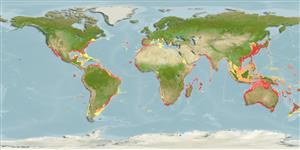Common names from other countries
Lớp phụ Cá sụn (cá mập và cá đuối) (sharks and rays) >
Carcharhiniformes (Ground sharks) >
Carcharhinidae (Requiem sharks)
Etymology: Carcharhinus: karcharos (Gr.), sharp or jagged; rhinus, an ancient name for sharks, from rhine (Gr.), rasp, both words alluding to a shark's jagged, rasp-like skin. (See ETYFish); brachyurus: a- (Gr.), not; carenatus, alternate spelling of carinatus (L.), keeled or carinate, referring to absence of dermal fold (dorsal ridge) between the dorsal fins [treated as a junior synonym of C. brachyurus by some workers]. (See ETYFish).
More on author: Günther.
Environment: milieu / climate zone / depth range / distribution range
Sinh thái học
Biển; Thuộc về nước lợ Cùng sống ở rạn san hô; Ở đại duơng, biển (Ref. 51243); Mức độ sâu 0 - 360 m (Ref. 58018). Subtropical; 45°N - 52°S, 122°W - 180°E
Western Atlantic: Mexico, Gulf of Mexico, Brazil to Argentina. Eastern Atlantic: off France southward and around the coast of southern Africa to central Natal, South Africa (Ref. 5578), including the Mediterranean. Possibly two separate populations in southern Africa (Ref. 3209). Western Pacific: Japan to New Zealand. Eastern Pacific: southern California, USA to the Gulf of California in Mexico and Peru.
Length at first maturity / Bộ gần gũi / Khối lượng (Trọng lượng) / Age
Maturity: Lm 230.0, range 245 - 240 cm
Max length : 325 cm TL con đực/không giới tính; (Ref. 2334); Khối lượng cực đại được công bố: 304.6 kg (Ref. 40637); Tuổi cực đại được báo cáo: 30 các năm (Ref. 3209)
Các tia vây lưng cứng (tổng cộng): 0; Các vây lưng mềm (tổng cộng): 0; Tia cứng vây hậu môn 0; Tia mềm vây hậu môn: 0. A large shark to with a bluntly pointed, broad snout, narrow, bent cusps on the upper teeth, and with no interdorsal ridge (Ref. 5578). Grey to bronzy in color, white below (Ref. 5578); fins mostly plain except for dusky tips on pelvic fins, as well as dusky to black tips and rear edges on pectoral fins (Ref. 9997).
A coastal and offshore shark (Ref. 9997) found along continental margins in most tropical and temperate seas. Occasionally enters large coastal bays and inshore areas (Ref. 6390). Occasionally found near the bottom (Ref. 6808). Migratory in the northern part of its range, moving northward in spring and summer and southward in autumn and winter (Ref. 244). Feeds on pelagic and bottom bony fishes, cephalopods, and small sharks and rays (Ref. 5578). Viviparous (Ref. 50449). Undoubtedly utilized for human consumption where it occurs (Ref. 244). Implicated in shark attacks on people (Ref. 9997).
Viviparous, with a yolk-sac placenta. Litter contains 7 to 20 pups (Ref. 6871, 6390). Young born at 59 - 70 cm TL (Ref. 6390). Pupping may occur at any time of the year but there is a peak in births in summer (Ref. 6390). Distinct pairing with embrace (Ref. 205).
Compagno, L.J.V., 1984. FAO Species Catalogue. Vol. 4. Sharks of the world. An annotated and illustrated catalogue of shark species known to date. Part 2 - Carcharhiniformes. FAO Fish. Synop. 125(4/2):251-655. Rome: FAO. (Ref. 244)
IUCN Red List Status (Ref. 130435)
Threat to humans
Traumatogenic (Ref. 4690)
Human uses
Các nghề cá: buôn bán nhỏ; cá để chơi: đúng
Thêm thông tin
Các tài liệu tham khảoNuôi trồng thủy sảnTổng quan nuôi trồng thủy sảnCác giốngDi truyềnElectrophoresesDi sảnCác bệnhChế biếnMass conversion
Các công cụ
Special reports
Download XML
Các nguồn internet
Estimates based on models
Preferred temperature (Ref.
115969): 11.6 - 23.8, mean 17.4 (based on 797 cells).
Phylogenetic diversity index (Ref.
82804): PD
50 = 0.5000 [Uniqueness, from 0.5 = low to 2.0 = high].
Bayesian length-weight: a=0.00468 (0.00230 - 0.00950), b=3.08 (2.91 - 3.25), in cm Total Length, based on LWR estimates for this species & Genus-body shape (Ref.
93245).
Mức dinh dưỡng (Ref.
69278): 4.5 ±0.0 se; based on diet studies.
Thích nghi nhanh (Ref.
120179): Rất thấp, thời gian nhân đôi của chủng quần tối thiểu là hơn 14 năm (K=0.04; tm=5-20; tmax=30; Fec=7).
Fishing Vulnerability (Ref.
59153): Very high vulnerability (87 of 100).
Climate Vulnerability (Ref.
125649): High vulnerability (57 of 100).
